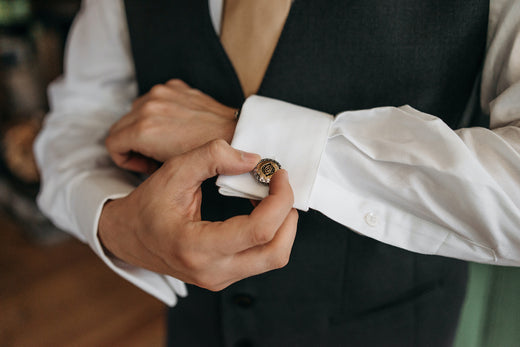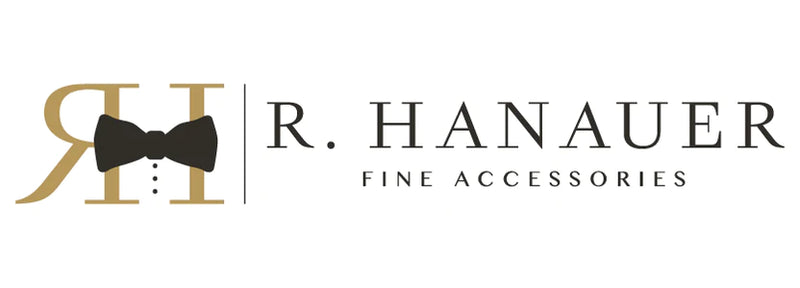Unlock the Power of Style with Cufflinks: When & How to Wear Them

At R. Hanauer, we value the details. The quality of a fabric, the intricacies of a pattern, the relationship between accessories. They all come together to create a sophisticated look that - when done with great intention - tell a story.
Sometimes, the pieces themselves carry their own story, like those passed down through generations. A tie clip, a monogrammed accessory, a family tartan and, of course, cufflinks, are commonly prized and shared with sons, nephews, and godsons.
In this edition of The Gentleman’s Guide, we'll spend some time with the small but mighty cufflink. It has waxed and waned in popularity over the last several centuries, but it has never disappeared from elegant settings. We’ll explore a little cufflink history and answer several common questions, including:
- What are cufflinks?
- What are the different types of cufflinks?
- How to wear cufflinks?
- When to wear cufflinks?

What Are Cufflinks?
Cufflinks literally link cuffs together. They are necessary when a dress shirt doesn’t have buttons at the cuff, like French cuffs, and are a handsome choice for a shirt with convertible cuffs.
The “face” of the cufflink is decorative, and the “backing” includes a combination of hardware to serve as the closure – holding both the face in place and the cuffs together.
A Dazzling World of Cufflink Types
There are a dizzying variety of cufflinks on the market today - most of which are considered to be jewelry due to their ornate presentation and inclusion of precious metals and gemstones.
Featuring the most popular type of closure, the backing of the bullet back has a cylindrical piece of metal that toggles from a vertical position when inserted through the buttonhole to a horizontal position to keep the cufflink in place.

Whale backs are similar to bullet backs, but the toggling mechanism tends to operate in a more fluid, rather than prescribed, manner. The backing may be any shape, and the post may be at an angle – like a whale’s tail on surfacing – instead of at a right angle to the face.
Fixed back, or fixed stud, cufflinks do not have any moveable hardware. This means putting them in requires that you manually secure them in place as you push the backing through the buttonhole. Some fixed backs are reversible.
Ball backs are like fixed backs in that the hardware isn’t moveable. The difference here is that the post of the fixed back is straight and the backing may be any shape, whereas the ball back post is curved and the backing is spherical.
As the name implies, a chain links the face and the backing of this type of cufflink. Some favor this type as the fit tends to be a bit looser at the wrist. Some chain link cufflinks are reversible.
Made of knotted silk yarn, these cufflinks tend to have a bit of stretch to them, making them both easy to use and comfortable. Being fabric, they come in a variety of colors, readily complement other fine accessories, and are the most affordable among cufflinks. The one drawback is that they’re a bit less durable than metal ones.

Snap links feature a face and backing that click together to hold the cuffs closed. This closure tends to be seen only in vintage pieces.
Newer are locking cufflinks, which cleverly fold while connecting the cuffs and then lock into place. The mechanism is akin to that of a wristwatch, and the effect is sleek and modern.
The design of the wraparound cufflink is different from that of the other types listed here and are a bit more visible than their counterparts as a result. Instead of the face on one side of the cuff and the backing on the other, these wraparound the fabric on the outside of the cuff. Modern takes on the wraparound cufflink feature a variety of materials, from leather and traditional fabric to wood and upcycled fabrics, like fire hoses!
A Bit Of Cufflink History
Cufflinks made their sartorial debut in the early 1600s during the reign of Louis XIV of France. The first cufflinks were chain link in style and featured silver, gold, gemstones, and intricate engravings, earning them a place only among the wealthy and elite. They were initially used in place of a button, and were therefore sometimes referred to as a cuff button.
By the 1700s, though, cufflinks were made more accessible and, therefore, more popular, as producers introduced versions in enamel and glass, and included semi-precious stones.
As the Industrial Revolution surged, production processes became even more efficient and affordable, and the cufflink became standard among well-dressed gentlemen. The motifs of the day were squarely inspired by nature, the arts, and history.
As the 1900s approached, the chain link was replaced by more secure and reliable closures, similar to the modern-day bullet back and whale back.
In the early part of the century, designs were simple and understated as the value proposition shifted from adornment to craftsmanship – until the Roaring 20s and Art Deco took over. This era saw contrasting colors, geometric patterns, technology-based motifs, like airplanes, automobiles, and skyscrapers, and even cufflinks made from Bakelite.

In time, men’s fashion changed dramatically and the suit fell out of favor as day-to-day wear – and the cufflink with it.
Today, cufflinks are typically reserved for formal attire and occasions. That said, some well-dressed gentlemen with a creative flair will opt for French or convertible cuffs in a professional environment as suits their fancy.
Modern day cufflinks come in a wide variety of materials, including traditional metals and also carbon fiber, titanium, and industrial metals. Cufflinks are anything but outdated.
When To Wear Cufflinks
When should a man wear cufflinks? It comes down to personal preference, as mentioned above, but they are almost always on scene at formal and semi-formal events.
Formal Events
Cufflinks are a must for black tie and white tie events. With a tuxedo – and, so a tuxedo shirt – expected at formal events, cufflinks will be a necessity. White tie affairs traditionally call for mother of pearl studs, and black tie events favor precious metals and sophisticated accents like diamonds, pearls, or gemstones.
Semi-Formal Events
Cocktail parties, upscale dinners, social gatherings, and weddings often require semi-formal attire, meaning a matching suit and either a bow tie or a necktie. With freedom of expression on your side, you can experiment with a wider variety of cufflink designs, colors and materials (like stainless steel, enamel, or even fabric).

Business Settings
As is the case with bowties, cufflinks are not standard in a business professional environment, but they most certainly add a touch of refinement and distinction to your attire. The most likely professions to see cufflinks in the workplace are certain segments of medicine and law. As a general rule, opt for classic designs in silver or gold, and avoid flashy or novelty cufflinks.
Casual Settings
If you enjoy wearing fine accessories casually, consider adding cufflinks as a way to elevate your outfit and express your unique taste. Opt for more casual cufflink designs, such as those made from leather, wood, or featuring interesting or meaningful patterns.
How To Wear Cufflinks
1. Choose the Right Shirt
Cufflinks work only with French cuffs or convertible cuffs. French cuffs are double-layered and folded back and fasten only with cufflinks. Convertible cuffs can be worn with either cufflinks or buttons.

2. Pair Cufflinks Carefully
When selecting cufflinks, consider the color, style, and level of formality of your outfit. Make sure your cufflinks complement rather than clash with your bow tie, pocket square, or other accessories.
3. Fasten Your Cufflinks
Unless you are aiming for sprezzatura style, fasten your cufflinks. Fold the cuff back on your shirt, align the buttonholes on both sides of the cuff, hold the two sides of the cuff together, and insert the cufflink through the buttonholes. Secure the cufflink by fastening the closure.
4. Show Them Off
When wearing cufflinks, make sure your jacket sleeves are tailored to the appropriate length. Allowing about half an inch of your shirt cuff to be visible will showcase your cufflinks and add a polished touch to your ensemble.

Chevron-style cufflinks that show off really nice against a blue blazer
Need ideas, inspiration, and other essential how-tos? Spend some time with our Style Fundamentals guides across our blog, and check out our Instagram, Facebook and YouTube feeds.

